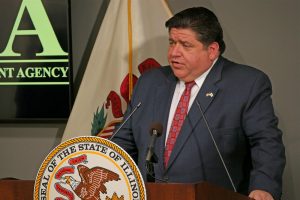COVID-19 outbreak sparks flood of executive orders
By Peter Hancock Capitol News Illinois — March 27, 2020
Gov. J.B. Pritzker updates members of the press on the state of COVID-19 in Illinois on March 16 at the Illinois Emergency Management Agency in Springfield. In just the first three months of this year, Pritzker has issued 12 executive orders, including 10 since he declared a public health disaster on March 9 due to the outbreak of the coronavirus disease, COVID-19. (Capitol News Illinois photo by Ben Orner)
SPRINGFIELD – Democratic Gov. J.B. Pritzker is on a pace to set a modern-day record for issuing the most executive orders by an Illinois governor.
Since 1999, which is as far back as the executive orders page of the governor’s website goes, the most executive orders any governor issued in a single year was 20. That mark was set by Gov. Pat Quinn in 2009. The average from 1999 through 2019 was 11.2 executive orders per year.
But in just the first three months of this year, Pritzker has already issued 12 executive orders, including 10 since he declared a public health disaster on March 9 due to the outbreak of the coronavirus disease, COVID-19.
Some of the orders Pritzker has issued deal with multiple, unrelated issues. On Tuesday, March 24, for example, he issued an order to expand the state’s health care workforce by suspending portions of a law requiring former or retired certified nursing assistants to undergo background and fingerprint checks in order to practice again and limiting them to just three months under a temporary license while the background checks are being completed.
Under the order they may now work for six months on a temporary license.
That same order, however, also contained a provision suspending a law requiring the Department of Juvenile Justice to give local prosecutors at least 30 days advance notice before releasing an offender from custody. And it contained another provision suspending a portion of the Coal Mining Act that requires the Miners’ Examining Board to conduct examinations at least once a month.
Some of the executive orders have made headlines, such as the one he issued Friday, March 20, the stay-at-home order directing people essentially to shelter in place except for limited purposes, imposing social distancing rules and ordering certain non-essential businesses to close.
That order also contained a provision halting residential evictions throughout the state for as long as the disaster proclamation remains in effect.
The following Monday, March 23, he issued a follow-up order amending the March 20 order to clarify that people could leave their homes to work for or obtain human services provided through the Department of Human Services, the Illinois Department of Children and Family Services or Medicaid.
That order also suspended a law requiring the Illinois Department of Corrections to provide relevant local prosecutors with 14 days advance notice of an inmate being given early release.
On March 19, he issued an order requiring health insurance companies to cover telehealth services. That order also allowed for the reinstatement of medical licenses for practitioners whose licenses have been lapsed or inactive for less than three years, as long as they meet certain conditions.
The first executive order Pritzker issued after the disaster proclamation came on Thursday, March 12, when he extended the deadline for people to submit cannabis license applications for craft growers, infusers or transporters. That deadline was moved back to March 30 instead of March 16.
A full list of all executive orders dating back to 1999 is available on the governor’s office website.







